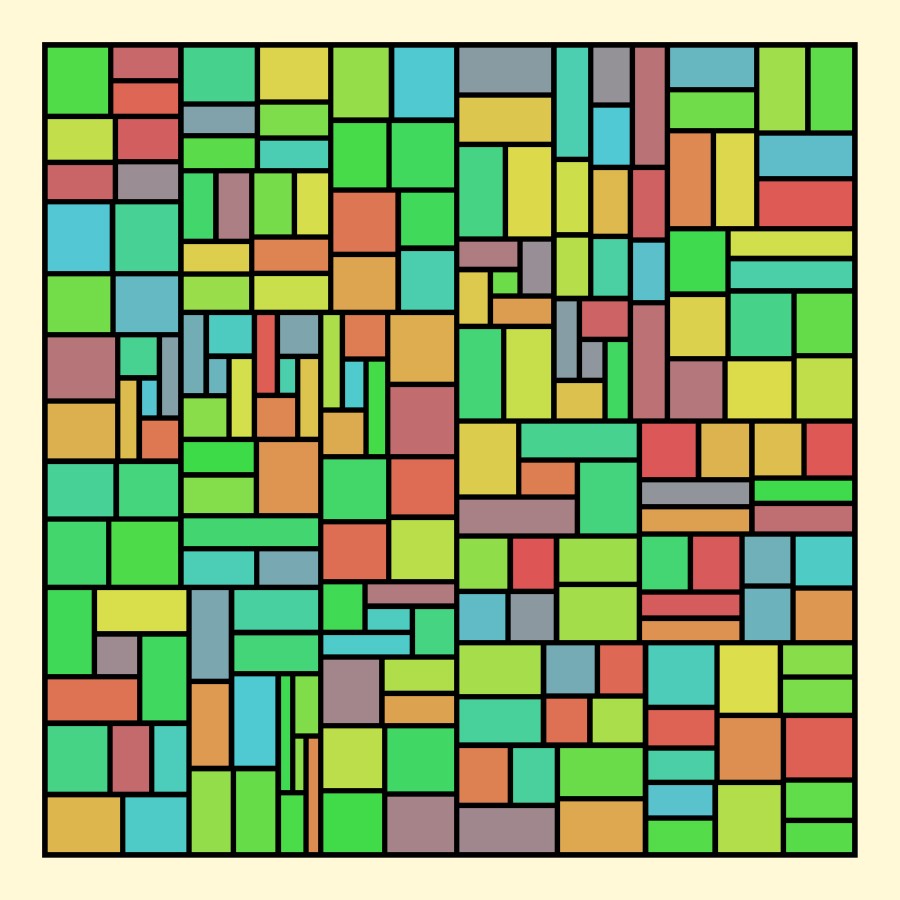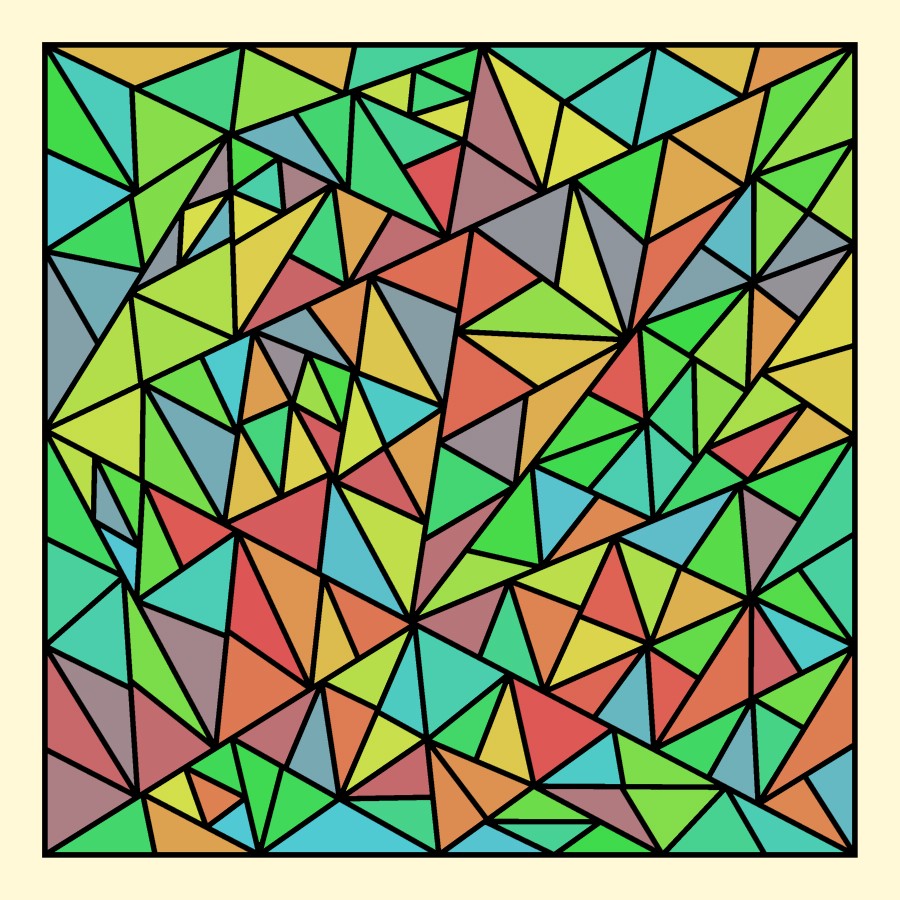Now two examples with just two layers, a top layer for the lines and a bottom layer to color the cells. Here’s one with 200 rectangles. Because cells are colored with index equal to n/Nmax, shuffling the colors often gives a more pleasing result. alt="5fab29ce64b66.jpg">
alt="5fab29ce64b66.jpg">
200Rectangles {
::fPzc0hn2tT1yutNMQw7Gw/DE6udkYEtiTBPU72EgAHggkDJ9UAj0KLmQRKQRna/33VP8jaJn
2zt5m0s7O7SyZnUrI2JUXOcAh4kOFw9o++k7BEVvUBlekfKTcZ8ImPJDkLzc1fqEbAbJnWVX
sFSkuSu3NycyM1K4LBBnN9MqP13jI0OpQJFlS9S+Goc4g6SrbYsowJNau3iKIC1jYKExS3Ge
AOD5gLzkwVSNIsEnVoLLEWQ7aoJXUUgc2QEiCW+I/xszwCFL18ghDSN28VKRdG5i1yqUCIFg
NODifjbSTJikXXVWTIJVqAtIHvAeAP6JCby4Vp5eVFjsb3w9uTuGUIgUXKTgmrsqpKF5Vb0w
wBmVuuhaPAWoAEOMRSpRJT4h0phTnMhRj6t1xqDb91gGsy4rtiEJCN3oMW8w7RKeOu975KRJ
+G8q6lxrUvc5NLm98cQpKrp5o0G/+zLbYs+mub0t/XF+E13OKHmZfEVNCniliHzkxZ89ituZ
crYd9pgT7niSAS4B0zDZdr9pZGbC+A4P2n1b7/xBJ0N6VSbp7by35h9W88MjpE4LE2lo2tT4
7Fo0+ElikiqEG23AaPNe+jYE2HUZ4pq8OLgKuFG85wfcU/U80V4KfVD6G6Blp403W3K1PgNv
Kh+6NG+rWQwHT7v87RltJvW5y7qUKWgbJlNb2dLeWVT9PvDOUgarvPaywBblj1re4G3bosoa
ruM3YQ3rqPtGno2uZUAjSk6EYNnRibHom/j2+fFNNQjCoRHlFSQHE6+KbNxqHl/Y/364RZsd
zwWsjnid4HMHdxo75MM6DsbDO2uFFy5G8BORmiqIQHD/uH8/Keusogpf65+pn7/Xeu0T55qN
n2yN8v1yt1nD302ZzNp1Ryv1ZkxmSZhbd+qkuN4hTjoM/L271R3H6iQ8cH2if+O8gQ/A/I/w
e9axZYbjPwcd4gfBHsArBB==
}
The original rectangle can also be divided into triangles. A few parameters are different. The first division of the rectangle can be into two, three, or four triangles. If two, a diagonal line crosses from corner to corner. If three, a point on one side is connected to two opposite corners. If four, a point in the center is connected to all four corners.
After the first division, triangles can be divided into two or four triangles. If two, a point on one side is connected to the opposite corner. If four, points on all three sides are connected to each other. Experiment.
200Triangles {
::EzUGWgn2tT1yutNMQw7Gw/DE6udkYksiTBPU72EgAHgikCk0TBMSrsYCFpAJdq9ffX9wPqlc
aP3mbi7uzsLpmdyM8EHXe5wBEiT4kAzj67T+uRwVLlg1j8TRqLnFH5TyBxycX9nS+GwYZ0KY
JGIV4sMvbEFkZyVwnCCOb6ZUfqvHhrcCuUwtC1S2GwOcQN06+lwLdCti5toKEh6R0l8EhbDL
AHhCwlrTZShC4GizwV2SuBUuGaK4llInNEhRBDbk/4ozQg8lKWwwBZaTxKJvuiC+aRVJBkSw
kkDJvy0ZZEe6Lrs1ESyESQxLw7/9OuKlbSHvKrwrCMyuZDz7bi1gEDIUWRK08iVNVZIvKtCG
OQvy1NV7FwAlA3hFSsapIlFSnGOdykIacvtOReYrvGUgRkcthnKwQz1StBv8ekynSa/eukbx
/BvIfe8K5zXeziZPNHkSbNNHV243eaZDj1v0dzu9cV6TgvdUOsy+IqaEOFLlPkLSyZ70adL4
W+66LBj2PDWAwXyu4ecm2kiv9+j9j6tz/4gC6m9Khx6+i4N259CeeuWbB2CuZJYddzfHHl1s
wexisiKkIsxB0e688HwMRvDywKkdT+NDgatFa8Hh/44+J4xrwd9K67m6epu80PW3KU3jtuqg
+mZM9nNAnNm2P87QNtuoWzy6qRKXg7H2md6ugnV1U/z7EHKRV1XHNZ4gtCx6lOcX7VURUtPb
L0a03q6Tj2xrNaGFERJCVKsmFRSaHomzxbPXRTToRB04jqCJoTE6ekt2X1jyfs/b96oRR7mh
txOeK2F/g5obM6eODjfHj2gjNaRdchG/BnKyQVEoSgf399fF32o4gpf42+hb7/Lut0T52q0n
2sN8v1st1hD3x2ZwNp1Lyv1TMKaKNKcrnXlotJe40Yak/F7d5o7TdRIevDbjf+u4Bh+B+x+h
96yizw2Gfgt6wB/CJgSqoC==
}
